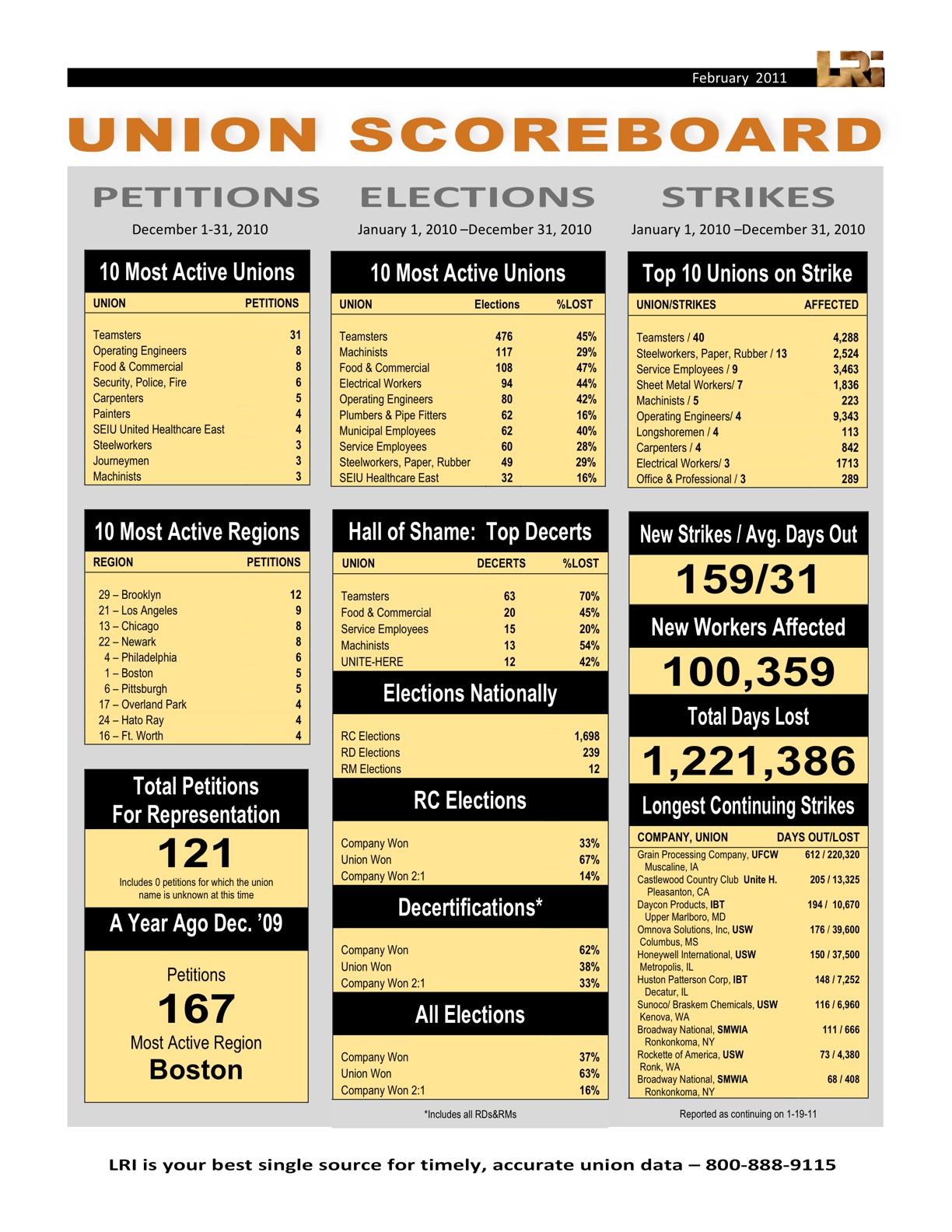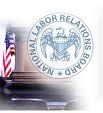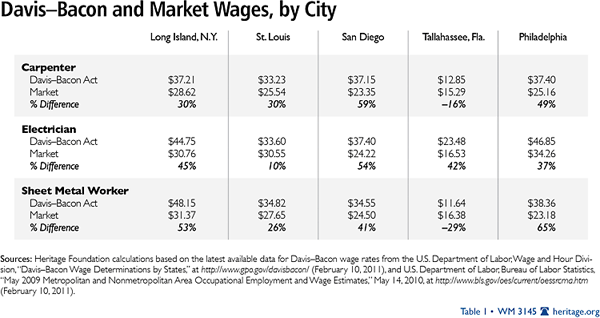 Labor Relations INK In this issue:
Labor Relations INK In this issue:
- Union Bailout Update
- New, Useful Websites
- Say Goodbye To More NJ Teamsters
- Scoreboard, Social Media Spotlight, Only In A Union and more…
Union Bailout Update  The fur is beginning to fly as new administrations, both in D.C. and in many of the states, begin to tie union issues to budget problems, and work to unravel the choke hold that Big Labor has had on legislative and regulatory processes the last few years. The NLRB backed down when 4 state Attorneys General rebuffed the NLRB General Counsel’s threat to sue. In a letter back to the Attorneys General, the acting GC said, “As you have unanimously expressed the opinion that the State Amendments can all be construed in a manner consistent with federal law, I believe your letter may provide a basis upon which this matter can be resolved without the necessity of costly litigation. My staff will shortly be in contact with the staff members you have designated to explore this issue further.” This threat isn’t over, but the firm line in the sand drawn by the Attorneys General of Arizona, South Carolina, South Dakota and Utah evidently threw a wrench in the NLRB gears. Utah’s Attorney General expects that the board will now agree to the status quo while waiting for a test case or congressional action. The House Subcommittee on Health, Employment, Labor and Pensions held a hearing to discuss emerging trends at the National Labor Relations Board. Subcommittee Chairman David P. Roe (R-TN) opened the hearing stating that “the board abandoned its traditional sense of fairness and neutrality and instead embraced a far-more activist approach.” The hearing panel reviewed several recent board decisions, memos from the acting NLRB General Counsel, and the proposed posting rule we’ve covered recently. The full House Committee on Education and the Workforce also held a hearing to review the policies and priorities of the Department of Labor. DOL Secretary Solis was taken to task on a number of issues, including budgeting allocations that enhanced “enforcement” activities yet underfunded the Office of Labor Management Standards, making union financial activity less transparent to the public. Solis attempted to defend the required use of PLAs for government contracts, and the elimination of the LM-2 form. When the House failed to pass an amendment designed to defund the NLRB for the remainder of the fiscal year 2011, they responded by proposing a budget that would cut $50 million from NLRB coffers. With congress nipping at their heels, it will be interesting to see how the NLRB responds to issues on its docket. The latest is whether or not the board will allow unions to sub-divide employees into even smaller groups for organizing purposes. This “opportunity” to change the rules came about during the board’s review of a case involving the United Steelworkers attempt to organize nurses at Specialty Healthcare. One last item from the federal front: the White House announced a new program whereby disgruntled employees can call a hotline set up by the American Bar Association, and secure a lawyer to sue their boss on a contingency fee basis. The DOL already has more attorneys on staff than any other department except for the Justice Department! This appears to “expand” their reach in an almost unlimited fashion. On the state level, Wisconsin Governor Scott Walker has stirred up a hornet’s nest with his proposed budget, and his plan to bar the state’s public unions from collective bargaining about any issue other than wages. Other stipulations of the plan include: • The state would stop collecting dues money from employee paychecks, forcing the unions to do their own collection • Public-union members would be given the option not to pay dues. • A secret-ballot vote would be required each year to determine whether a majority of workers still want the union • Each public-sector union would have to negotiate new contracts every year • The limit for raises of state employees and teachers would be tied to the consumer price index, unless approved higher via referendum (firefighters and law enforcement exempted) Unionists from across the country have been rallying to the Wisconsin state capital in support of their state union compatriots. Out-of-state demonstrators have clogged the house floor, and the South Central Federation of Labor of Wisconsin has laid the groundwork for a general strike. With 97 unions represented by the federation, the repercussions could be massive. Richard Epstein, a professor at the University of Chicago, believes that such a strike is a strong probability. “They see this as a trillion-dollar proposition if it replicates itself across the country,” Epstein said. A couple of state lines over, Ohio is considering a similar bill to limit the collective bargaining rights of public-sector unions, and grant similar rights for employees who do not want to join the union to opt out of paying dues. ********** New, Useful Web Sites
The fur is beginning to fly as new administrations, both in D.C. and in many of the states, begin to tie union issues to budget problems, and work to unravel the choke hold that Big Labor has had on legislative and regulatory processes the last few years. The NLRB backed down when 4 state Attorneys General rebuffed the NLRB General Counsel’s threat to sue. In a letter back to the Attorneys General, the acting GC said, “As you have unanimously expressed the opinion that the State Amendments can all be construed in a manner consistent with federal law, I believe your letter may provide a basis upon which this matter can be resolved without the necessity of costly litigation. My staff will shortly be in contact with the staff members you have designated to explore this issue further.” This threat isn’t over, but the firm line in the sand drawn by the Attorneys General of Arizona, South Carolina, South Dakota and Utah evidently threw a wrench in the NLRB gears. Utah’s Attorney General expects that the board will now agree to the status quo while waiting for a test case or congressional action. The House Subcommittee on Health, Employment, Labor and Pensions held a hearing to discuss emerging trends at the National Labor Relations Board. Subcommittee Chairman David P. Roe (R-TN) opened the hearing stating that “the board abandoned its traditional sense of fairness and neutrality and instead embraced a far-more activist approach.” The hearing panel reviewed several recent board decisions, memos from the acting NLRB General Counsel, and the proposed posting rule we’ve covered recently. The full House Committee on Education and the Workforce also held a hearing to review the policies and priorities of the Department of Labor. DOL Secretary Solis was taken to task on a number of issues, including budgeting allocations that enhanced “enforcement” activities yet underfunded the Office of Labor Management Standards, making union financial activity less transparent to the public. Solis attempted to defend the required use of PLAs for government contracts, and the elimination of the LM-2 form. When the House failed to pass an amendment designed to defund the NLRB for the remainder of the fiscal year 2011, they responded by proposing a budget that would cut $50 million from NLRB coffers. With congress nipping at their heels, it will be interesting to see how the NLRB responds to issues on its docket. The latest is whether or not the board will allow unions to sub-divide employees into even smaller groups for organizing purposes. This “opportunity” to change the rules came about during the board’s review of a case involving the United Steelworkers attempt to organize nurses at Specialty Healthcare. One last item from the federal front: the White House announced a new program whereby disgruntled employees can call a hotline set up by the American Bar Association, and secure a lawyer to sue their boss on a contingency fee basis. The DOL already has more attorneys on staff than any other department except for the Justice Department! This appears to “expand” their reach in an almost unlimited fashion. On the state level, Wisconsin Governor Scott Walker has stirred up a hornet’s nest with his proposed budget, and his plan to bar the state’s public unions from collective bargaining about any issue other than wages. Other stipulations of the plan include: • The state would stop collecting dues money from employee paychecks, forcing the unions to do their own collection • Public-union members would be given the option not to pay dues. • A secret-ballot vote would be required each year to determine whether a majority of workers still want the union • Each public-sector union would have to negotiate new contracts every year • The limit for raises of state employees and teachers would be tied to the consumer price index, unless approved higher via referendum (firefighters and law enforcement exempted) Unionists from across the country have been rallying to the Wisconsin state capital in support of their state union compatriots. Out-of-state demonstrators have clogged the house floor, and the South Central Federation of Labor of Wisconsin has laid the groundwork for a general strike. With 97 unions represented by the federation, the repercussions could be massive. Richard Epstein, a professor at the University of Chicago, believes that such a strike is a strong probability. “They see this as a trillion-dollar proposition if it replicates itself across the country,” Epstein said. A couple of state lines over, Ohio is considering a similar bill to limit the collective bargaining rights of public-sector unions, and grant similar rights for employees who do not want to join the union to opt out of paying dues. ********** New, Useful Web Sites  The NLRB just announced the launch of the latest revision of its web site, and it does appear much improved. According to the NLRB, the site will include: • All Board decisions are now posted to the site at the time they are issued, rather than after a three-day holding period. • Unpublished decisions, which do not appear in the official bound volumes of Board decisions. • A new case-management system that will be deployed to all regional offices by the end of this fiscal year. • A data section that tracks NLRB activities over the years by the numbers. • Improved navigation. • A subscription service that allows users to choose email delivery of press releases, decisions and memos. You can also find a link to connect to the site via typical social media venues, such as Facebook and Twitter. Perhaps even more helpful is this new web site by the Cornerstone Foundation. Not all union members agree with the way unions spend their dues money on politics, such as the estimated $10 million that Big Labor squandered in Arkansas in an attempt to unseat then-senator Blanche Lincoln. The site helps union members secure their lawfully entitled refund to that portion of union dues used by their union for purposes other than direct representation. Here’s how the site describes its purpose:
The NLRB just announced the launch of the latest revision of its web site, and it does appear much improved. According to the NLRB, the site will include: • All Board decisions are now posted to the site at the time they are issued, rather than after a three-day holding period. • Unpublished decisions, which do not appear in the official bound volumes of Board decisions. • A new case-management system that will be deployed to all regional offices by the end of this fiscal year. • A data section that tracks NLRB activities over the years by the numbers. • Improved navigation. • A subscription service that allows users to choose email delivery of press releases, decisions and memos. You can also find a link to connect to the site via typical social media venues, such as Facebook and Twitter. Perhaps even more helpful is this new web site by the Cornerstone Foundation. Not all union members agree with the way unions spend their dues money on politics, such as the estimated $10 million that Big Labor squandered in Arkansas in an attempt to unseat then-senator Blanche Lincoln. The site helps union members secure their lawfully entitled refund to that portion of union dues used by their union for purposes other than direct representation. Here’s how the site describes its purpose:
UnionRefund.org is a project designed to help educate, organize and assist union members nationwide in exercising their “Beck rights” as set forth by the U.S. Supreme Court. In 1988, the U. S. Supreme Court decided the landmark case Communication Workers v. Beck, which established the rights of employees working under union contracts to pay only those union dues or fees necessary for performance of a union’s employee representation duties. Under Beck, fees to support union expenditures unrelated to workplace representation, such as political, social, or charitable contributions, are not mandatory.
An employee can go on the site, click on his state, select his union, and then the site produces the letters required to secure the refund. The site also sends a “courtesy notification” letter to the union letting them know that the letter is coming, and that someone else is “looking over their shoulder” to make sure they pay! ********** SCORE BOARD  Who are the winners (and losers) of the labor movement? Don’t guess, just check the LRI Scoreboard
Who are the winners (and losers) of the labor movement? Don’t guess, just check the LRI Scoreboard
View this month’s scoreboard (archives also located here).
Download a PDF of this month’s scoreboard
**********
TSA Handout  Big Labor was just handed another 40,000 or so public employees when Transportation Security Administration head John Pistole agreed to grant partial collective bargaining rights to TSA employees. Until this decision, the TSA agents could unionize, but had no bargaining rights. Only 12,000 had joined the ranks of AFGE to date, but more agents will begin voting in March. AFGE president John Gage remarked at a press conference that the TSA ranks 240 out of 244 federal agencies on morale. Chances are good that a majority of them will opt for representation by the union. ********* Social Media Spotlight
Big Labor was just handed another 40,000 or so public employees when Transportation Security Administration head John Pistole agreed to grant partial collective bargaining rights to TSA employees. Until this decision, the TSA agents could unionize, but had no bargaining rights. Only 12,000 had joined the ranks of AFGE to date, but more agents will begin voting in March. AFGE president John Gage remarked at a press conference that the TSA ranks 240 out of 244 federal agencies on morale. Chances are good that a majority of them will opt for representation by the union. ********* Social Media Spotlight  Big Labor continues to improve at using social media for its purposes. This recent report (PDF) includes highlights of interviews with 23 organizers about how they use new social media tools and work-and-family issues in organizing campaigns, particularly with women and younger employees. At the February 13th “Organizing 2.0” conference held in New York City, the focus was on “Online Organizing.” The conference included: • Hands-on training on relevant software, case studies, and suggestions for best next steps. • How to move from having an online presence, to using it effectively to achieve mission goals. • What works best to win campaigns, serve members and drive up individual engagement. To see more detail about the material covered, review the registration form here. In New York, public unions that have typically spent millions in each election cycle for direct advertising, such as billboards, TV and radio, are launching a new strategy that focuses on social media instead. Direct confrontation with policies is tarnishing the union image, so the union is attempting to train people to take a grass-roots approach, using social media to build “social credibility.” Union leaders admit that the typical “winter ad wars” are costing them big time in both dollars (SEIU has dropped around $10 million each cycle) and public relations backlash. ********* Only In A Union What do you do if you are the majority owner in a company, and your company posts a fourth quarter loss of $652 million? If you are the UAW, you pay all of your employees a bonus! How do you make the books balance? Why of course, apply for $3 billion in (tax-payer) subsidized loans from the Department of Energy! ********* Organizing By Extortion
Big Labor continues to improve at using social media for its purposes. This recent report (PDF) includes highlights of interviews with 23 organizers about how they use new social media tools and work-and-family issues in organizing campaigns, particularly with women and younger employees. At the February 13th “Organizing 2.0” conference held in New York City, the focus was on “Online Organizing.” The conference included: • Hands-on training on relevant software, case studies, and suggestions for best next steps. • How to move from having an online presence, to using it effectively to achieve mission goals. • What works best to win campaigns, serve members and drive up individual engagement. To see more detail about the material covered, review the registration form here. In New York, public unions that have typically spent millions in each election cycle for direct advertising, such as billboards, TV and radio, are launching a new strategy that focuses on social media instead. Direct confrontation with policies is tarnishing the union image, so the union is attempting to train people to take a grass-roots approach, using social media to build “social credibility.” Union leaders admit that the typical “winter ad wars” are costing them big time in both dollars (SEIU has dropped around $10 million each cycle) and public relations backlash. ********* Only In A Union What do you do if you are the majority owner in a company, and your company posts a fourth quarter loss of $652 million? If you are the UAW, you pay all of your employees a bonus! How do you make the books balance? Why of course, apply for $3 billion in (tax-payer) subsidized loans from the Department of Energy! ********* Organizing By Extortion  SEIU – United Healthcare Workers West approached Prime Healthcare Services a little over a year ago demanding a “quick” deal for SEIU members at PHS’ Centinela Hospital Medical Center in California, so that SEIU could avoid a challenge from the upstart NUHW. SEIU threatened to release reports that supposedly showed that patients were acquiring serious blood infections at PHS’ hospitals even though SEIU knew that the data identified conditions present on admission. SEIU then stepped up the pressure by having an investment fund created by SEIU and other unions, make false and misleading statements to Medical Properties Trust (MPT), a publicly traded real estate investment trust which serves as PHS’ landlord and/or lender at several of its hospitals. SEIU then deployed a state senator, Denise Ducheney, a long-time friend of SEIU, to repeat the false claim that PHS’ hospitals were not in compliance with California’s earthquake safety laws, a gross misrepresentation of publicly verifiable facts. SEIU has continued using similar tactics to pressure PHS into neutrality agreements, but PHS has remained rock solid in defiance of the union’s extortion attempts, and has made a criminal referral to the United States Attorneys’ Office regarding SEIU’s activities. Elsewhere in California, another Big Labor group has found a unique way to ensure contracts for new construction projects are funneled to them. Here’s how it works: A labor coalition called CURE (California Unions for Reliable Energy) challenges construction projects on environmental grounds. However, once the construction contract is let to CURE’s largest affiliate, the State Building & Construction Trades Council of California, CURE then drops the charges, effectively blocking rival unions from the opportunity to bid for the work. CURE and the council operate out of the same Sacramento office and have the same top executive, Robert Balgenorth. Since 2000, CURE has been involved in all 12 renewable energy projects planned for Southern California. CURE (and its affiliated unions) are engaged in 8 of the projects, and has suits still pending against 2 developers that did not use project labor agreements. ********* Say Goodbye To More NJ Teamsters
SEIU – United Healthcare Workers West approached Prime Healthcare Services a little over a year ago demanding a “quick” deal for SEIU members at PHS’ Centinela Hospital Medical Center in California, so that SEIU could avoid a challenge from the upstart NUHW. SEIU threatened to release reports that supposedly showed that patients were acquiring serious blood infections at PHS’ hospitals even though SEIU knew that the data identified conditions present on admission. SEIU then stepped up the pressure by having an investment fund created by SEIU and other unions, make false and misleading statements to Medical Properties Trust (MPT), a publicly traded real estate investment trust which serves as PHS’ landlord and/or lender at several of its hospitals. SEIU then deployed a state senator, Denise Ducheney, a long-time friend of SEIU, to repeat the false claim that PHS’ hospitals were not in compliance with California’s earthquake safety laws, a gross misrepresentation of publicly verifiable facts. SEIU has continued using similar tactics to pressure PHS into neutrality agreements, but PHS has remained rock solid in defiance of the union’s extortion attempts, and has made a criminal referral to the United States Attorneys’ Office regarding SEIU’s activities. Elsewhere in California, another Big Labor group has found a unique way to ensure contracts for new construction projects are funneled to them. Here’s how it works: A labor coalition called CURE (California Unions for Reliable Energy) challenges construction projects on environmental grounds. However, once the construction contract is let to CURE’s largest affiliate, the State Building & Construction Trades Council of California, CURE then drops the charges, effectively blocking rival unions from the opportunity to bid for the work. CURE and the council operate out of the same Sacramento office and have the same top executive, Robert Balgenorth. Since 2000, CURE has been involved in all 12 renewable energy projects planned for Southern California. CURE (and its affiliated unions) are engaged in 8 of the projects, and has suits still pending against 2 developers that did not use project labor agreements. ********* Say Goodbye To More NJ Teamsters  Teamsters Local 863 is home to about 1300 workers employed at a C&S Wholesale Grocers warehouse in Woodbridge, N.J. C&S has determined that it will be more cost-effective to close the warehouse and move its operations out of New Jersey. The result of this prudent business decision: Woodbridge Mayor John McCormac, along with state and local labor leaders, set up a blue ribbon panel, and commissioned the Center for Labor & Community Research to create an economic impact study. The report bears the accusatory title, “Economic Treason: Case Study of the C&S Wholesale Grocers and the Destruction of New Jersey Jobs.” It is quite certain the report did not delve into the economic impact that the Teamsters union had on C&S’s decision to move out. *********** Big Labor’s Political Stripes
Teamsters Local 863 is home to about 1300 workers employed at a C&S Wholesale Grocers warehouse in Woodbridge, N.J. C&S has determined that it will be more cost-effective to close the warehouse and move its operations out of New Jersey. The result of this prudent business decision: Woodbridge Mayor John McCormac, along with state and local labor leaders, set up a blue ribbon panel, and commissioned the Center for Labor & Community Research to create an economic impact study. The report bears the accusatory title, “Economic Treason: Case Study of the C&S Wholesale Grocers and the Destruction of New Jersey Jobs.” It is quite certain the report did not delve into the economic impact that the Teamsters union had on C&S’s decision to move out. *********** Big Labor’s Political Stripes  If there has ever been a question about the political leanings of Big Labor, this short article should clear matters up. Written on the AFL-CIO blog, Joe Uehlein, the executive director of Labor Network for Sustainability, appeals to environmentalists and sustainability advocates to support Big Labor in its “time of need,” referring specifically to the actions that many state governments are considering in relation to unions (right-to-work laws, the suspension of collective bargaining for public-sector unions, etc.). Among his “reasons” Big Labor deserves support are: • Organized labor is the most powerful force for fighting conservative ideology. • The alliance of labor, environmental and sustainability movements has been crucial in supporting and passing environmental legislation. • The right-wing strategy is to divide progressive groups. • Unions are far more likely to support sustainability policies if in their hour of need they receive support from sustainability activists. • Even on the minimal basis of “the enemy of my enemy is my friend” sustainability activists should be try to keep organized labor from being “cut off at their knees.” It would stand to reason that there are many union members who disagree with Big Labor’s political agenda, yet are forced to continue to pay into the huge financial machine that feeds Big Labor’s ability to spend so freely in the political arena. Perhaps access by more union workers to the Union Refund web site mentioned above would help to de-fang unions’ political malfeasance. Spread the word! ********* Davis-Bacon Act and PLAs Forcing the government to pay wages calculated on the basis of the Davis-Bacon Act formula for construction projects cost Americans about $10.9 billion in unnecessary spending in 2010 alone. The Heritage Foundation did the math, reviewed the policies, and provides some insight into this federal law run amuck: Under the DBA, contractors on all federally funded construction projects must pay their workers at least prevailing market wages. However, the Department of Labor (DOL) estimates DBA rates using a highly flawed methodology. The Inspector General has criticized the DOL for: • Using a self-selected sample instead of a scientific random sample to estimate DBA rates; • Allowing 100 percent error rates in audited samples of returned DBA surveys; and • Permitting long delays in updating DBA surveys. • These errors cause DBA rates to bear little relation to actual prevailing wages. Table 1 displays DBA rates and market wages estimated by the Bureau of Labor Statistics for five American cities. As the table shows, DBA rates are well above market wages in most (though not all) cities.
If there has ever been a question about the political leanings of Big Labor, this short article should clear matters up. Written on the AFL-CIO blog, Joe Uehlein, the executive director of Labor Network for Sustainability, appeals to environmentalists and sustainability advocates to support Big Labor in its “time of need,” referring specifically to the actions that many state governments are considering in relation to unions (right-to-work laws, the suspension of collective bargaining for public-sector unions, etc.). Among his “reasons” Big Labor deserves support are: • Organized labor is the most powerful force for fighting conservative ideology. • The alliance of labor, environmental and sustainability movements has been crucial in supporting and passing environmental legislation. • The right-wing strategy is to divide progressive groups. • Unions are far more likely to support sustainability policies if in their hour of need they receive support from sustainability activists. • Even on the minimal basis of “the enemy of my enemy is my friend” sustainability activists should be try to keep organized labor from being “cut off at their knees.” It would stand to reason that there are many union members who disagree with Big Labor’s political agenda, yet are forced to continue to pay into the huge financial machine that feeds Big Labor’s ability to spend so freely in the political arena. Perhaps access by more union workers to the Union Refund web site mentioned above would help to de-fang unions’ political malfeasance. Spread the word! ********* Davis-Bacon Act and PLAs Forcing the government to pay wages calculated on the basis of the Davis-Bacon Act formula for construction projects cost Americans about $10.9 billion in unnecessary spending in 2010 alone. The Heritage Foundation did the math, reviewed the policies, and provides some insight into this federal law run amuck: Under the DBA, contractors on all federally funded construction projects must pay their workers at least prevailing market wages. However, the Department of Labor (DOL) estimates DBA rates using a highly flawed methodology. The Inspector General has criticized the DOL for: • Using a self-selected sample instead of a scientific random sample to estimate DBA rates; • Allowing 100 percent error rates in audited samples of returned DBA surveys; and • Permitting long delays in updating DBA surveys. • These errors cause DBA rates to bear little relation to actual prevailing wages. Table 1 displays DBA rates and market wages estimated by the Bureau of Labor Statistics for five American cities. As the table shows, DBA rates are well above market wages in most (though not all) cities.
Repealing the law would be one solid measure in attacking our out-of-control government spending. ********* How Unions Treat Their Own  The NLRB has ruled that the Air Line Pilots Association violated the National Labor Relations Act with respect to Unit 1, the union that represents the professional employees who work for the pilot’s union. Don McClure, Unit 1 president, exclaimed, “This ruling confirms what Unit 1 has been saying for the last two years, that ALPA acted unlawfully and has repeatedly ignored the law and the rights of its own employees.” In May 2009, management at ALPA unilaterally imposed changed pay, fringe benefits and work rules on the Unit 1 staff after contract negotiations failed to produce an agreement. Unit 1 filed ULPs against ALPA, and estimates that it will cost ALPA well in excess of $2 million to rescind the unilaterally imposed contract terms. Said McClure, “For the world’s largest pilots’ union to flaunt the law in such an egregious manner is reprehensible. The law judge agreed with us.” ********* Sticky Fingers Current charges or sentences of embezzling union officials:
The NLRB has ruled that the Air Line Pilots Association violated the National Labor Relations Act with respect to Unit 1, the union that represents the professional employees who work for the pilot’s union. Don McClure, Unit 1 president, exclaimed, “This ruling confirms what Unit 1 has been saying for the last two years, that ALPA acted unlawfully and has repeatedly ignored the law and the rights of its own employees.” In May 2009, management at ALPA unilaterally imposed changed pay, fringe benefits and work rules on the Unit 1 staff after contract negotiations failed to produce an agreement. Unit 1 filed ULPs against ALPA, and estimates that it will cost ALPA well in excess of $2 million to rescind the unilaterally imposed contract terms. Said McClure, “For the world’s largest pilots’ union to flaunt the law in such an egregious manner is reprehensible. The law judge agreed with us.” ********* Sticky Fingers Current charges or sentences of embezzling union officials:
| Jonathan Thompson | BLE | $21,948 |
| Tamara Schult | NTUE | $1,000 |
| Frank Kmiec | BMWE | $19,461 |
| Tammy Allen | RWDSU | $45,767 |





